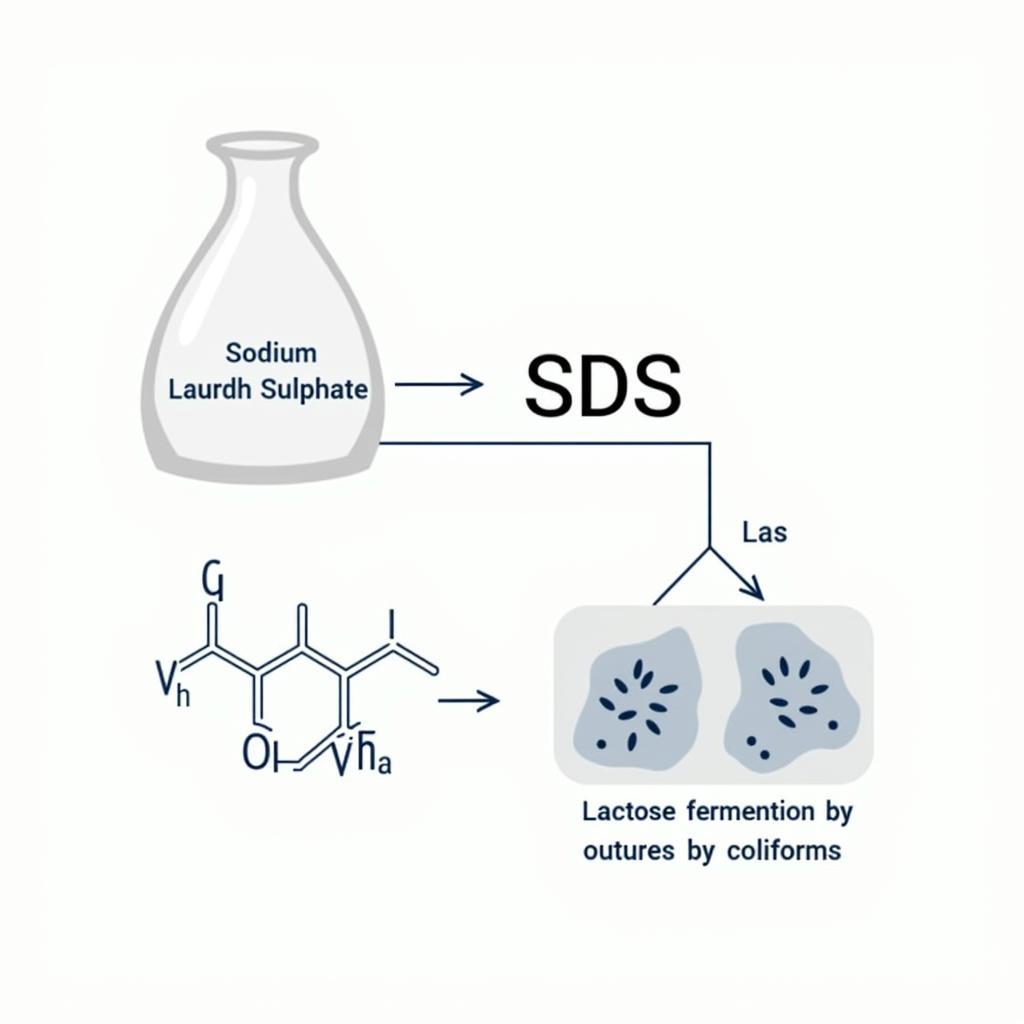Lauryl sulphate broth (LSB) is a selective liquid medium primarily used for the detection of coliforms and other members of the Enterobacteriaceae family in water, food, and other samples. Its effectiveness lies in its ability to inhibit the growth of Gram-positive bacteria while encouraging the growth of Gram-negative bacteria, specifically coliforms, making it a valuable tool in microbiology and quality control.
Understanding the Composition and Function of Lauryl Sulphate Broth
LSB’s selective nature stems from the presence of sodium lauryl sulphate, also known as sodium dodecyl sulphate (SDS), a powerful anionic detergent. This compound acts as a surfactant, disrupting the cell membranes of Gram-positive bacteria, effectively inhibiting their growth. The broth also contains lactose, providing a carbon source that coliforms can ferment, producing gas as a byproduct. This gas production is a key indicator of the presence of coliforms and is often visualized using Durham tubes, small inverted tubes placed within the LSB tubes.
 Lauryl Sulphate Broth Composition
Lauryl Sulphate Broth Composition
The broth also includes peptone, which provides nitrogen and other essential nutrients for bacterial growth. Dipotassium phosphate acts as a buffer, maintaining a stable pH, crucial for optimal bacterial growth. The combination of these ingredients creates a selective and differentiating environment that facilitates the identification of coliforms.
Applications of Lauryl Sulphate Broth in Various Fields
LSB finds widespread applications in a variety of industries, including:
- Water Quality Testing: LSB is frequently used to assess the potability of water samples by detecting the presence of coliforms, indicators of fecal contamination.
- Food Safety: In the food industry, LSB helps monitor the hygienic quality of food products and detect potential contamination by coliforms.
- Environmental Monitoring: LSB can be used to analyze environmental samples like soil and wastewater to determine the levels of coliform bacteria.
- Pharmaceutical Industry: LSB plays a role in quality control during the production of pharmaceuticals, ensuring sterility and the absence of coliform contamination.
Interpreting the Results of Lauryl Sulphate Broth Tests
The interpretation of LSB test results is relatively straightforward. A positive result for coliforms is indicated by the production of gas within the Durham tube. The amount of gas produced can provide a semi-quantitative estimate of the coliform concentration. The absence of gas production suggests the absence of coliforms or their presence below the detectable limit.
What does gas production in LSB indicate?
Gas production in LSB indicates the presence of coliforms that are capable of fermenting lactose.
How is LSB different from other selective media?
LSB is specifically designed to inhibit Gram-positive bacteria, making it ideal for detecting coliforms in samples where these bacteria might otherwise overgrow the target organisms. Other selective media may target different bacterial groups or utilize different selective agents.
“LSB is an essential tool in any microbiology lab, particularly for water and food testing,” states Dr. Nguyen Thi Lan Anh, Head of Microbiology at the Hanoi Institute of Public Health. “Its ease of use and selectivity make it an invaluable tool for identifying potential contamination.”
Best Practices for Using Lauryl Sulphate Broth
To ensure accurate and reliable results, it’s crucial to follow best practices when using LSB:
- Sterilization: Proper sterilization of the broth and equipment is essential to prevent false-positive results due to contamination.
- Incubation: Incubation temperature and duration should be carefully controlled according to standard protocols.
- Interpretation: Timely and accurate interpretation of gas production is critical for reliable results.
- Quality Control: Regular quality control checks should be performed to ensure the integrity of the LSB and the accuracy of the testing procedure.
“Accurate and reliable results depend on meticulous technique and adherence to standardized protocols,” adds Dr. Tran Van Minh, a senior food safety consultant. “Careful attention to detail is essential when using LSB for any application.”
Conclusion
Lauryl sulphate broth is a valuable and versatile tool for detecting coliforms in various samples, contributing significantly to water quality assessment, food safety, environmental monitoring, and pharmaceutical quality control. Its selectivity and ease of use make it a preferred choice for microbiologists. Understanding its composition, applications, and interpretation ensures accurate and reliable results, ultimately contributing to public health and safety. By adhering to best practices, researchers and technicians can maximize the effectiveness of LSB in their respective fields. Using lauryl sulphate broth effectively helps in ensuring product quality and safeguarding public health.
FAQ
- What is the purpose of using Durham tubes in LSB? (To capture gas produced during lactose fermentation by coliforms.)
- What are the typical incubation conditions for LSB? (35-37°C for 24-48 hours.)
- Can LSB be used to identify specific coliform species? (No, it primarily detects the presence of coliforms, further tests are required for species identification.)
- What are some common sources of error when using LSB? (Improper sterilization, incorrect incubation, misinterpretation of results.)
- What are alternatives to LSB for coliform detection? (Membrane filtration, chromogenic agar media.)
- How long can prepared LSB be stored? (Store prepared media at 2-8°C away from light, check for any signs of deterioration before use.)
- Can LSB be used for non-water samples? (Yes, it can be used for food, environmental, and pharmaceutical samples.)
Mô tả các tình huống thường gặp câu hỏi.
Một số tình huống thường gặp câu hỏi về Môi Trường Lauryl Sulphate Broth bao gồm việc thắc mắc về thành phần, cách sử dụng, cách đọc kết quả và ứng dụng của nó trong các lĩnh vực khác nhau.
Gợi ý các câu hỏi khác, bài viết khác có trong web.
Bạn có thể tìm hiểu thêm về các phương pháp kiểm tra vi sinh khác trên website của trường.



